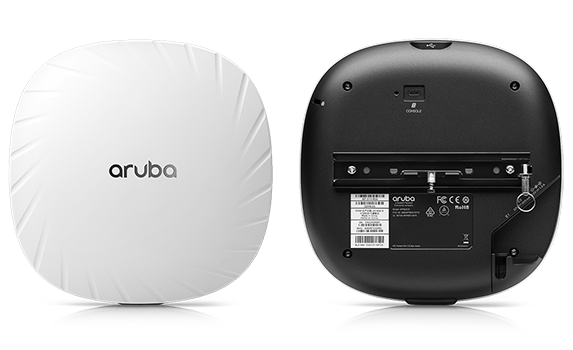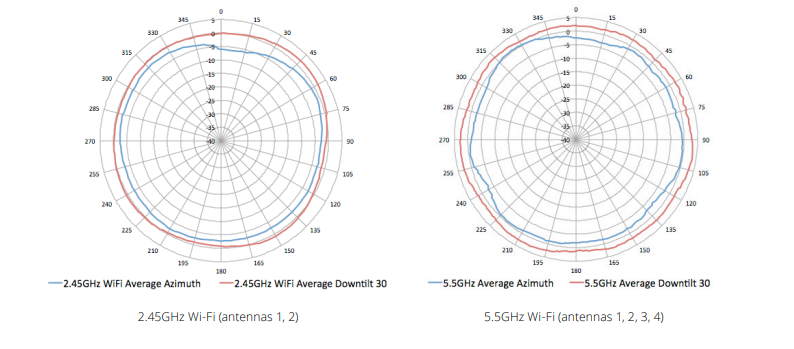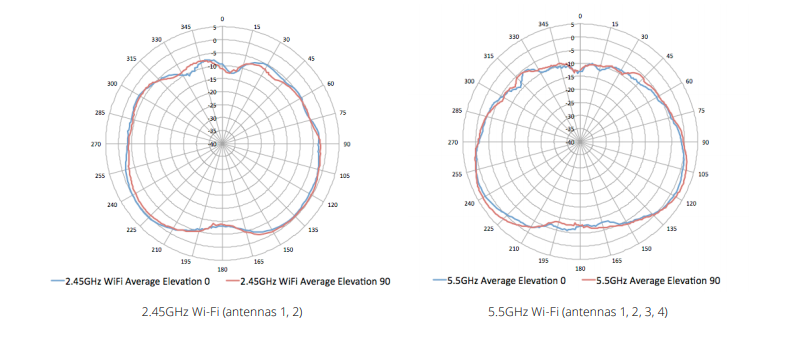|
Hardware Variants
- AP-514: External antenna models
- AP-515: Internal antenna models
Wi-Fi Radio Specifications
- AP type: Indoor, dual radio, 5GHz 802.11ax 4x4 MIMO and 2.4GHz 802.11ax 2x2 MIMO
- 5GHz radio:
- Four spatial stream Single User (SU) MIMO for up to 4.8Gbps wireless data rate to individual 4SS HE160 802.11ax client devices (max)
- Two spatial stream Single User (SU) MIMO for up to 1.2Gbps wireless data rate to individual 2SS HE80 802.11ax client devices (typical)
- Four spatial stream Multi User (MU) MIMO for up to 4.8Gbps wireless data rate to up to four 1SS or two 2SS HE160 802.11ax DL-MU-MIMO capable client devices simultaneously (max)
- Four spatial stream Multi User (MU) MIMO for up to 2.4Gbps wireless data rate to up to four 1SS or two 2SS HE80 802.11ax DL-MU-MIMO capable client devices simultaneously (typical)
- 2.4GHz radio:
- Two spatial stream Single User (SU) MIMO for up to 575Mbps wireless data rate to individual 2SS HE40 802.11ax client devices or to two 1SS HE40 802.11ax DL-MU-MIMO capable client devices simultaneously (max)
- Two spatial stream Single User (SU) MIMO for up to 287Mbps wireless data rate to individual 2SS HE20 802.11ax client devices or to two 1SS HE20 802.11ax DL-MU-MIMO capable client devices simultaneously (typical)
- Support for up to 256 associated client devices per radio, and up to 16 BSSIDs per radio
- Supported frequency bands (country-specific restrictions apply):
- 2.400 to 2.4835GHz
- 5.150 to 5.250GHz
- 5.250 to 5.350GHz
- 5.470 to 5.725GHz
- 5.725 to 5.850GHz
- Available channels: Dependent on configured regulatory domain
- Dynamic frequency selection (DFS) optimizes the use of available RF spectrum
- Supported radio technologies:
- 802.11b: Direct-sequence spread-spectrum (DSSS)
- 802.11a/g/n/ac: Orthogonal frequency-division multiplexing (OFDM)
- 802.11ax: Orthogonal frequency-division multiple access (OFDMA) with up to 16 resource units (for an 80MHz channel)
- Supported modulation types:
- 802.11b: BPSK, QPSK, CCK
- 802.11a/g/n: BPSK, QPSK, 16-QAM, 64-QAM, 256-QAM (proprietary extension)
- 802.11ac: BPSK, QPSK, 16-QAM, 64-QAM, 256-QAM, 1024-QAM (proprietary extension)
- 802.11ax: BPSK, QPSK, 16-QAM, 64-QAM, 256-QAM, 1024-QAM
- 802.11n high-throughput (HT) support: HT20/40
- 802.11ac very high throughput (VHT) support: VHT20/40/80/160
- 802.11ax high efficiency (HE) support: HE20/40/80/160
- Supported data rates (Mbps) 1:
- 802.11b: 1, 2, 5.5, 11
- 802.11a/g: 6, 9, 12, 18, 24, 36, 48, 54
- 802.11n (2.4GHz): 6.5 to 300 (MCS0 to MCS15, HT20 to HT40)
- 802.11n (5GHz): 6.5 to 600 (MCS0 to MVC31, HT20 to HT40)
- 802.11ac: 6.5 to 3,467 (MCS0 to MCS9, NSS = 1 to 4, VHT20 to VHT160)
- 802.11ax (2.4GHz): 3.6 to 574 (MCS0 to MCS11, NSS = 1 to 2, HE20 to HE40)
- 802.11ax (5GHz): 3.6 to 4,803 (MCS0 to MCS11, NSS = 1 to 4, HE20 to HE160)
- 802.11n/ac packet aggregation: A-MPDU, A-MSDU
- Transmit power: Configurable in increments of 0.5 dBm
- Maximum (aggregate, conducted total) transmit power (limited by local regulatory requirements):
- 2.4 GHz band: +21 dBm (18dBm per chain)
- 5 GHz band: +24 dBm (18 dBm per chain)
- Note: conducted transmit power levels exclude antenna gain. For total (EIRP) transmit power, add antenna gain.
- Advanced Cellular Coexistence (ACC) minimizes the impact of interference from cellular networks
- Maximum ratio combining (MRC) for improved receiver performance
- Cyclic delay/shift diversity (CDD/CSD) for improved downlink RF performance
- Space-time block coding (STBC) for increased range and improved reception
- Low-density parity check (LDPC) for high-efficiency error correction and increased throughput
- Transmit beam-forming (TxBF) for increased signal reliability and range
- 802.11ax Target Wait Time (TWT) to support low-power client devices
Wi-Fi Antennas
- AP-514:
- Four RP-SMA connectors for external dual band antennas (A0 through A3, corresponding with radio chains 0 through 3). Worst-case internal loss between radio interface and external antenna connectors (due to diplexing circuitry): 1.3dB in 2.4GHz and 1.7dB in 5GHz.
- AP-515:
- Four integrated dual-band downtilt omni-directional antennas for 4x4 MIMO with peak antenna gain of 4.2dBi in 2.4GHz and 7.5dBi in 5GHz. Built-in antennas are optimized for horizontal ceiling mounted orientation of the AP. The downtilt angle for maximum gain is roughly 30 degrees.
- Combining the patterns of each of the antennas of the MIMO radios, the peak gain of the effective per-antenna pattern is 3.8dBi in 2.4GHz and 4.6dBi in 5GHz.
|
Other Interfaces
- E0: HPE SmartRate port (RJ-45, maximum negotiated speed 2.5Gbps)
- Auto-sensing link speed (100/1000/2500BASE-T) and MDI/MDX
- 2.5Gbps speed complies with NBase-T and 802.3bz specifications
- POE-PD: 48Vdc (nominal) 802.3af/802.3at POE
- E1: 10/100/1000BASE-T Ethernet network interface (RJ-45)
- Auto-sensing link speed and MDI/MDX
- Link aggregation (LACP) support between both network ports for redundancy and increased capacity
- DC power interface: 12Vdc (nominal, +/- 5%), accepts 2.1mm/5.5mm center-positive circular plug with 9.5mm length
- USB 2.0 host interface (Type A connector)
- Capable of sourcing up to 1A / 5W to an attached device
- Bluetooth 5 and Zigbee (802.15.4) radio
- Bluetooth: up to 8dBm transmit power (class 1) and -95dBm receive sensitivity
- Zigbee: up to 8dBm transmit power and -97dBm receive sensitivity
- Integrated vertically polarized omnidirectional antenna with roughly 30 degrees downtilt and peak gain of 3.5dBi (AP-515) or 4.9dBi (AP-514)
- Visual indictors (two multi-color LEDs): for System and Radio status
- Reset button: factory reset, LED mode control (normal/off)
- Serial console interface (proprietary, micro-B USB physical jack)
- Kensington security slot
Power Sources and Consumption
- The AP supports direct DC power and Power over Ethernet (POE; on port E0)
- When both power sources are available, DC power takes priority over POE
- Power sources are sold separately; see the ordering Information section below for details
- When powered by DC or 802.3at POE, the AP will operate without restrictions
- When powered by 802.3af POE and with the IPM feature enabled, the AP will start up in unrestricted mode, but it may apply restrictions depending on the POE budget and actual power. What IPM restrictions to apply, and in what order, is programmable.
- When powered by 802.3af POE with the IPM feature disabled, the AP operates in power-save mode, and will apply some fixed restrictions:
- The USB interface and E1 Ethernet port are disabled
- The 5GHz radio is restricted to 2x2 operation
- Maximum (worst-case) power consumption:
- DC powered: 17W
- POE powered (802.3at): 19W
- POE powered (802.3af): 13.5W
- All numbers above are without an external USB device connected. When sourcing the full 5W power budget to such a device, the incremental (worst-case) power consumption for the AP is up to 6.5W.
- Maximum (worst-case) power consumption in idle mode: 11W (DC or POE)
- Maximum (worst-case) power consumption in deep-sleep mode: 1W (DC or POE)
Mounting
- A mounting bracket has been pre-installed on the back of the AP. This bracket is used to secure the AP to any of the (sold separately) mount kits; see the ordering Information section below for details.
Mechanical
- Dimensions/weight (AP-515; unit, excluding mount bracket):
- (H) 46mm x (W) 200mm x (D) 200mm (1.8" x 7.9" x 7.9")
- Weight: 810g (28.5oz)
- Dimensions/weight (AP-515; shipping):
- (H) 72mm x (W) 230mm x (D) 220mm (2.8" x 9.1" x 9.1")
- Weight: 1,010g (35.5oz)
Environmental
- Operating conditions
- Temperature: 0°C to +50°C / +32°F to +122°F
- Humidity: 5% to 93% non-condensing
- AP is plenum rated for use in air-handling spaces
- ETS 300 019 class 3.2 environments
- Storage and transportation conditions
- Temperature: -40°C to +70°C / -40F to +158°F
- Humidity: 5% to 93% non-condensing
- ETS 300 019 classes 1.2 and 2.3 environments
Reliability
- Mean Time Between Failure (MTBF): 560,000 hrs (64yrs) at +25°C operating temperature.
Regulatory
- FCC/ISED
- CE Marked
- RED Directive 2014/53/EU
- EMC Directive 2014/30/EU
- Low Voltage Directive 2014/35/EU
- UL/IEC/EN 60950
- EN 60601-1-1, EN60601-1-2
For more country-specific regulatory information and approvals, please see your Aruba representative.
Regulatory Model Numbers
- AP-514: APIN0514
- AP-515: APIN0515
Certifications
- UL2043 plenum rating
- Wi-Fi Alliance:
- Wi-Fi CERTIFIED a, b, g, n, ac
- Wi-Fi CERTIFIED ax2
- WPA, WPA2 and WPA3 – Enterprise, Personal
- WMM, WMM-PS, Wi-Fi Vantage, W-Fi Agile Multiband
- Wi-Fi Location3
- Passpoint (release 2)
- Bluetooth SIG
- Ethernet Alliance (POE, PD device, class 4)
Warranty
- Aruba limited lifetime warranty
Minimum Software Versions
- ArubaOS & Aruba InstantOS 8.4.0.0
|





